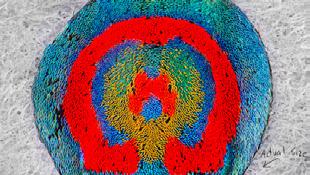
5 minute read
María Fernanda Cardoso
Three continents and 30 years of art making.
The work of María Fernanda Cardoso has a consistent feature – looking at the different ways geometry manifesting itself in living creatures. Cardoso has developed a powerful body of work based on the intrinsic forms of animals and plants, and combining them in unexpected ways. Her work evolves in series that are developed over a long periods of time, from sculpture to scientific research, through to public performance.
Initially when Cardoso still lived in Colombia, she would take local materials and native dead animals in order to build sculptures and enigmatic objects alluding to pre-Columbian myths and indigenous traditions. Typical objects such as totumas, earth soaps, homemade glue, bocadillos, and other elements pertaining to local cultures were combined in surprising works. Pieces with flies, grasshoppers, snakes, wall lizards and frogs are considered key pieces of contemporary Colombian art: one of them, Corona para una princesa Chibcha(Crown for a Chibcha Princess) was awarded the first prize for the II Biennial at Bogotá’s Museum of Modern Art in 1990.
In the early 1990s, Cardoso moved to the United States, where she began her research on fleas – a ubiquitous domestic parasite. A few years later, the Cardoso Flea Circus, initially a performance belonging to the realm of art, becomes an authentic mass show. Simultaneously, Cardoso investigates the behaviour of insects, with a particular interest in the phenomenon of camouflage, characteristic of some species that may be seen as a reflection of the immigrant’s will to belong and to become one with her context.
After living in San Francisco for several years, Cardoso moved to Sydney, Australia. This led to a renewed investigation of different traditions and materials, such as sheep’s wool and emu feathers, while preserving an emphasis on the intrinsic geometry of the organic. Cardoso devotes long periods of time to her series, with her work on fleas taking a whole decade. Since the beginning of this century, the artist has undertaken an investigation into the incredible formal diversity of the reproductive organs in some animals, particularly at the microscopic level, in a long-term project on the morphology of reproductive organs of small animals and insects, featured in the Museum of Copulatory Organs (MoCO).
In the last decade, Cardoso has delved further into her research on plants and animals, often resorting to scientific tools and processes to create images otherwise impossible to attain. The Naked Flora series shows close-ups of reproductive organs of flowers, composite images obtained by a complex optical and digital setup. On the Origins of Art I and II and the Actual Size series focus on the elaborate courtship “dances” of miniature Peacock spiders. In recent years she has created several large-scale public works: Sandstone Pollen, scientifically accurate pollen models digitally carved in sandstone. While I Live I Will Grow, a living urban sculpture that embodies non-human timeframes as a powerful commentary about the transience of monuments, and Tree Full of Life, a large tree whose foliage is entirely composed of insects that resemble leaves. Gumnuts, her latest series, uses seeds from various species of Australian trees to create vibrant optical pieces that highlight the intricate morphologies of this overlooked but ever present feature of the local landscape.
José Roca & Alejandro Marin Excerpts from: Animalario de María Fernanda Cardoso. Bogotá: Seguros Bolívar, 2013. p5

María Fernanda Cardoso Emu Flag #1, 2007 emu feathers, fibreglass netting, metal rod, glue 209 x 180 x 20 cm

María Fernanda Cardoso Reversible B (Emu rectangle worn), 2006-2008 180 x 120cm
María Fernanda Cardoso: Timeline
1987 — Moves to NY from Bogota, Colombia – completes Masters of Fine Arts, Sculpture at Yale University 1990.
1989 — CORN COIL

1990 Arte Colombiano de los 80: Escultura. Centro Colombo Americano. Bogota, Colombia.
1994 Ante America. (Touring exhibition). Biblioteca Luis Angel Arango, Bogota, Colombia.
Collection: Tate Modern, London and the Museum of Contemporary Art, Sydney 1992
1990 — CROWN FOR A CHIBCHA PRINCESS
II Bienal de Bogotá. Museo de Arte Moderno. Bogota, Colombia. First Prize Collection: DAROS Latinamerica Collection

Returns to Bogota.
1991 — Moves to California.
1992 — CALABAZAS

1992 — AMERICAN MARBLE

1992 — CEMETERY / VERTICAL GARDEN (1992-1999)

1999 Modern Starts: People, Places, Things, Museum of Modern Art. New York, U.S.A
2003 Zoomorphia: María Fernanda Cardoso. MCA Museum of Contemporary Art. Sydney
Collection: Perez Art Museum, Miami
1994 — CARDOSO FLEA CIRCUS (1994-2000)

Cardoso Flea Circus, live performances and exhibitions including , San Francisco Exploratorium, The New Museum of Contemporary Art, New York, Centre Georges Pompidou, Paris, Sydney Opera House.
Collection : Tate Modern, London, UK
1994 — WOVEN WATER / SUBMARINE LANDSCAPE (1994-2003)

2003 Woven Water. 50th International Art Exhibition Venice Biennale. ILLA Pavillion, curated by Irma Aristizábal.
2015 Contingent Beauty: Contemporary Art from Latin America. The Museum of Fine Arts Houston, USA
Collection: Museum of Fine Arts Houston, Houston
1997 — Moves to Sydney
2002 — BUTTERFLY DRAWINGS SERIES (2002-2003)

2006 — EMU SERIES (2006-2009)

2008 — IT’S NOT SIZE THAT MATTERS IT IS SHAPE (2008-2011)

2008 — MUSEUM OF COPULATORY ORGANS (MOCO) (2008-2012)
Museum of Copulatory Organs (MoCO). 18th Biennale of Sydney. Sydney, Australia. Collection: National Gallery of Australia

2009 — GUMNUTS KURU ALALA (2009-21)
2011 Kuru Alala, Tjampi Desert Weavers residency 2009-12 Kuru Ala: Eyes Open Tjanpi Dessert Weavers. María Fernanda Cardoso, Alison Clouson – a nation-wide touring exhibition 2015

2014 — SANDSTONE POLLEN (2014-2016)
International Convention Centre ICC, Darling Harbour, Sydney. Commissioned by Lend Lease.

2014 — MARATUS SERIES (2014-PRESENT)
On the Origin of Art, Museum of Old and New Art (MONA). Hobart, Tasmania.
Collection: Tate Modern, London and the Museum of Contemporary Art Australia, Sydney


2015 — WHILE I LIVE I WILL GROW (2015-2018)
Green Square Public Art Program Commissioned by the City of Sydney Council.







